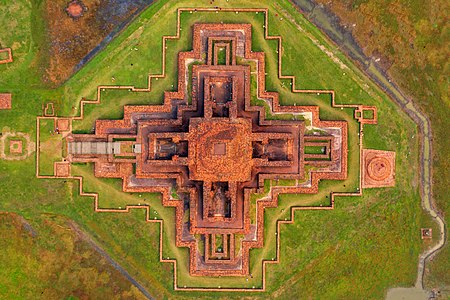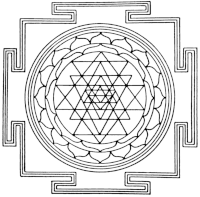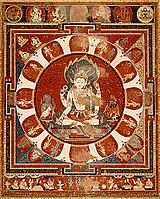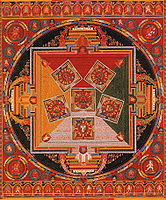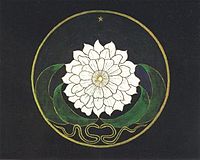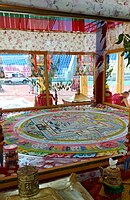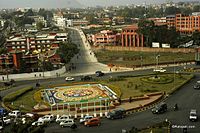
Mandala
A mandala (Sanskrit: मण्डल, romanized: maṇḍala, lit. 'circle', [ˈmɐɳɖɐlɐ]) is a geometric configuration of symbols. In various spiritual traditions, mandalas may be employed for focusing attention of practitioners and adepts, as a spiritual guidance tool, for establishing a sacred space and as an aid to meditation and trance induction. In the Eastern religions of Hinduism, Buddhism, Jainism and Shinto it is used as a map representing deities, or especially in the case of Shinto, paradises, kami or actual shrines.[1][2]
For other uses, see Mandala (disambiguation).Buddhist architecture often applied mandala as the blueprint or plan to design Buddhist structures, including temple complex and stupas. A notable example of mandala in architecture is the 9th century Borobudur in Central Java, Indonesia. It is built as a large stupa surrounded by smaller ones arranged on terraces formed as a stepped pyramid, and when viewed from above, takes the form of a giant tantric Buddhist mandala, simultaneously representing the Buddhist cosmology and the nature of mind.[31] Other temples from the same period that also have mandala plans include Sewu, Plaosan and Prambanan. Similar mandala designs are also observable in Cambodia, Thailand and Myanmar.
In science[edit]
Circular diagrams are often used in phylogenetics, especially for the graphical representation of phylogenetic relationships. Evolutionary trees often encompass numerous species that are conveniently shown on a circular tree, with images of the species shown on the periphery of a tree. Such diagrams have been called phylogenetic mandalas.[32]
In archaeology[edit]
One of the most intense archaeological discoveries in recent years that could redefine the history of eastern thought and tradition of mandala is the discovery of five giant mandalas in the valley of Manipur, India, made with Google Earth imagery. Located in the paddy field in the west of Imphal, the capital of Manipur, the Maklang geoglyph is perhaps the world's largest mandala built entirely of mud. The site wasn't discovered until 2013 as its whole structure could only be visible via Google Earth satellite imagery. The whole paddy field, locally known as Bihu Loukon, is now protected and announced as historical monument and site by the government of Manipur in the same year. The site is situated 12 km aerial distance from Kangla with the GPS coordinates of 24° 48' N and 93° 49' E. It covers a total area of around 224,161.45 square meters. This square mandala has four similar protruding rectangular ‘gates’ in the cardinal directions guarded each by similar but smaller rectangular ‘gates’ on the left and right. Within the square there is an eight petalled flower or rayed-star, recently called as Maklang ‘Star fort’ by the locals, in the centre covering a total area of around 50,836.66 square meters. The discovery of other five giant mandalas in the valley of Manipur is also made with Google Earth. The five giant mandalas, viz., Sekmai mandala, Heikakmapal mandala, Phurju twin mandalas and Sangolmang mandala are located on the western bank of the Iril River.[34] Another two fairly large mandala shaped geoglyph at Nongren and Keinou are also reported from Manipur valley, India, in 2019. They are named as Nongren mandala and Keinou mandala.[35]
In contemporary use[edit]
Fashion designer Mandali Mendrilla designed an interactive art installation called Mandala of Desires (Blue Lotus Wish Tree) made in peace silk and eco friendly textile ink, displayed at the China Art Museum in Shanghai in November 2015. The pattern of the dress was based on the Goloka Yantra mandala, shaped as a lotus with eight petals. Visitors were invited to place a wish on the sculpture dress, which will be taken to India and offered to a genuine living Wish Tree.[38][39]


